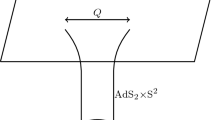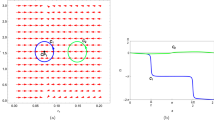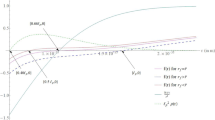Abstract
We investigate extremal charged black hole solutions in the four-dimensional string frame Gauss-Bonnet gravity with the Maxwell field and the dilaton. Without curvature corrections, the extremal electrically charged dilatonic black holes have singular horizon and zero Bekenstein entropy. When the Gauss-Bonnet term is switched on, the horizon radius expands to a finite value provided curvature corrections are strong enough. Below a certain threshold value of the Gauss-Bonnet coupling the extremal black hole solutions cease to exist. Since decreasing Gauss-Bonnet coupling corresponds to decreasing string coupling g s , the situation can tentatively be interpreted as classical indication on the black hole—string transition. Previously the extremal dilaton black holes were studied in the Einstein-frame version of the Gauss-Bonnet gravity. Here we work in the string frame version of the theory with the S-duality symmetric dilaton function as required by the heterotic string theory.
Similar content being viewed by others
References
L. Susskind, [arXiv:hep-th/9309145].
G. T. Horowitz and J. Polchinski, Phys. Rev. D 55, 6189 (1997).
J. M. Maldacena, [arXiv:hep-th/9607235].
L. Cornalba, M. S. Costa, J. Penedones, and P. Vieira, J. High Energy Phys. 0612, 023 (2006); [arXiv:hepth/0607083].
A. Giveon and D. Kutasov, J. High Energy Phys. 0701, 071 (2007).
Th. Damour and G. Veneziano, Nucl. Phys. B 568, 93 (2000).
R. R. Khuri, Phys. Lett. B 470, 73 (1999).
A. Sen, J. High Energy Phys. 0505, 059 (2005); [arXiv:hep-th/0411255]; V. Hubeny, A. Maloney, and M. Rangamani, J. High Energy Phys. 0505, 035 (2005); [arXiv:hep-th/0411272].
C. Chen, D. V. Gal’tsov, and D. G. Orlov, Phys. Rev. D 75, 084030 (2007); [arXiv:hep-th/0701004]; Phys. Rev. D 78, 104013 (2008); [arXiv:0809.1720].
D. J. Gross and E. Witten, Nucl. Phys. B 277, 1 (1986).
A. Sen, J. High Energy Phys. 0603, 008 (2006); [arXiv:hep-th/0508042].
B. de Wit, Fortsch. Phys. 54, 183 (2006); [arXiv:hepth/0511261].
T. Mohaupt, [arXiv:hep-th/0512048].
P. Prester, J. High Energy Phys. 0602, 039 (2006); [arXiv:hep-th/0511306].
A. Sen, Mod. Phys. Lett. A 10, 2081 (1995); [arXiv:hepth/9504147]; J. High Energy Phys. 0509, 038 (2005); [arXiv:hep-th/0506177].
G. Lopes Cardoso, B. de Wit, and T. Mohaupt, Nucl. Phys. B 567, 87 (2000); [arXiv:hep-th/9906094].
J. A. Harvey and G. W. Moore, Phys. Rev. D 57, 2323 (1998); [arXiv:hep-th/9610237].
Nucl. Phys. B 298, 741 (1988).
S. J. Poletti, J. Twamley, and D. L. Wiltshire, Class. Quant. Grav. 12, 1753 (1995); [Erratum-ibid. 12 (1995) 2355] [arXiv:hep-th/9502054].
A. Sen, Int. J. Mod. Phys. A 9, 3707 (1994); [arXiv:hepth/9402002].
J. Harvey and J. Liu, Phys. Lett. B 268, 40 (1991).
Author information
Authors and Affiliations
Corresponding author
Additional information
The article is published in the original.
Rights and permissions
About this article
Cite this article
Gal’tsov, D.V., Davydov, E.A. Curvature-corrected dilatonic black holes and black hole—string transition. Jetp Lett. 89, 102–107 (2009). https://doi.org/10.1134/S0021364009030023
Received:
Published:
Issue Date:
DOI: https://doi.org/10.1134/S0021364009030023




